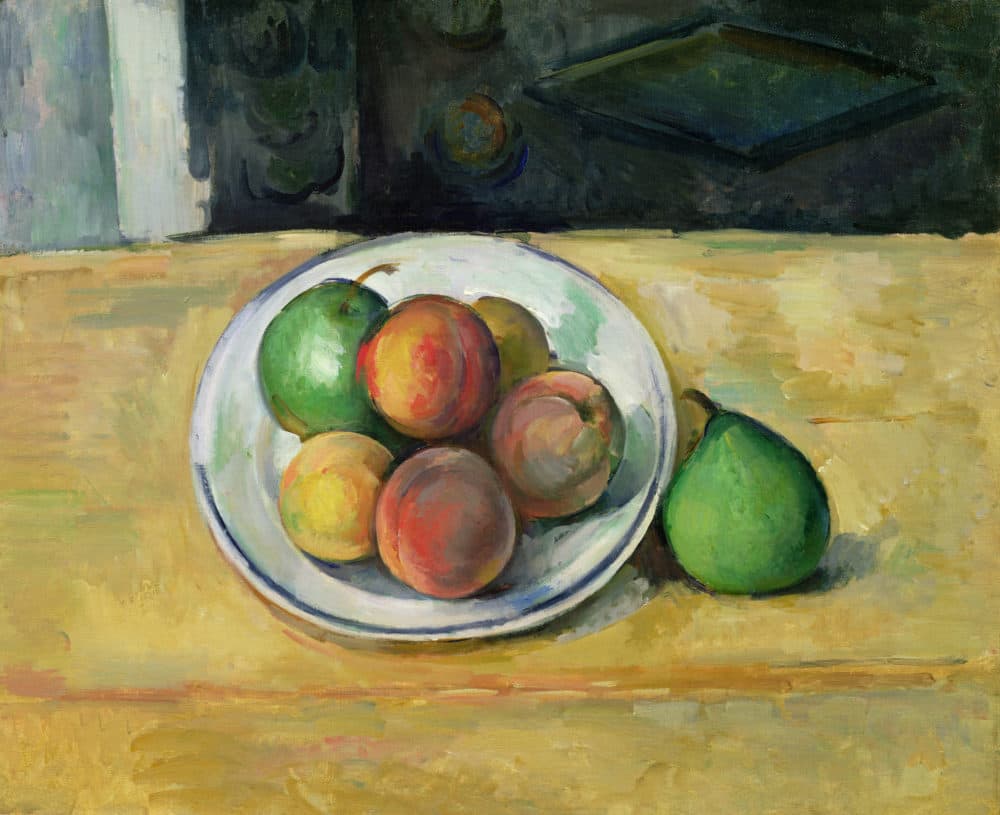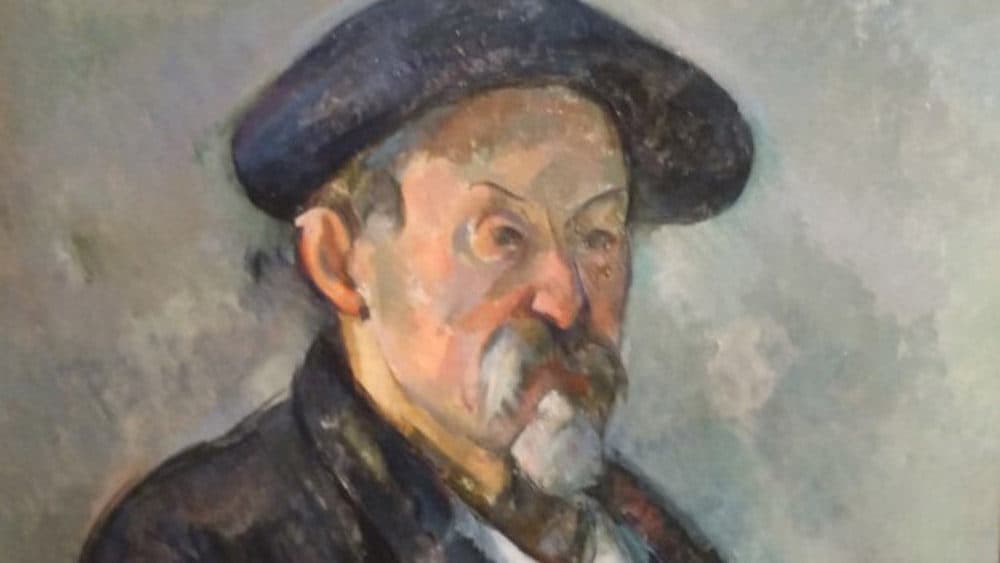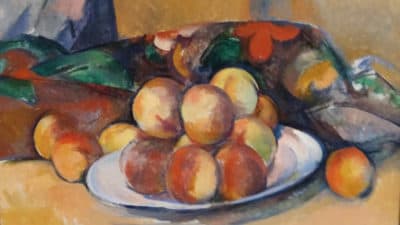Advertisement
A Concise Cézanne Exhibit At The MFA Maps Connections With His Contemporaries

An exceptional little exhibition—and one of my favorite kinds—will be at Boston’s Museum of Fine Arts through October 17. The show, “Paul Cézanne: Influence,” is mostly about the influence of Cézanne on later artists, but also looks at the influence of some earlier artists upon him.
Curator Katie Hanson has assembled a small group of pictures that sets one small room at the MFA buzzing with connections. This show focuses on art history, but it’s really more about the nature of art itself and the fascinating and complicated relationships among artists—even masters from centuries apart.
One thing that makes this show indispensable for me is that while two of the major paintings by Cézanne in this show belong to the MFA, the rest are borrowed from private collections, and as with most exhibitions, this is a unique opportunity to see all these paintings together. It may also be the only chance we’ll ever get to see the rest of them at all.

The show includes superb examples from three of the subjects we most associate with Cézanne: portrait, still life, and landscape. The first wall is a series of portraits, and the first portrait you see is Cézanne’s very last self-portrait (“Self-Portrait with a Beret,” 1898-1900), painted around the time the artist had turned 60—one of the masterpieces of the MFA’s own collection.
There’s some element of defeat in this image—the artist’s shoulders are slouching, his mustache is drooping, even the beret flops downward on his head. He looks older than 60. But his face, his upper body, and the gray wall behind him is alive with painterly activity, mazes of intersecting planes, a geometry of nuanced color. And at the emotional center of this painting are the artist’s eyes—steadfast, determined, neither turning away nor giving anything away either. A portrait of someone with an inner life.

Cézanne’s own look is quite different from the inscrutable mask-like face of his wife (painted in 1877), keeping her secrets in the famous portrait of her in a red chair (another highlight of the MFA’s own collection). But it’s not her face that’s the center of attention, it’s her voluminous striped dress billowing like a striped umbrella or tent (a close-up of these stripes could be mistaken for a forest) that ruthlessly upstages almost everything else in the painting.
Hung between these paintings is one of those marvelous early Cézanne portraits (from 1866—the earliest Cézanne in this show), the thick paint virtually sculpted with a palette knife. This vivid, intense image of “Uncle Dominique” is displayed just above another small portrait, Alberto Giacometti’s monochromatic (mostly gray), heartbreaking, and scary painting of his brother (“Head of Diego,” 1961) from almost a century later.
How much even part of this wall of portraits gives us to look at and think about! How different Cézanne’s early paintings are from his later ones, how different his self-portrait is from the portrait of his wife. How obviously different Cézanne was from Giacometti, yet how much they have in common—how much Cézanne, the Post-Impressionist, was also one of the prime movers of modern art.
After the portrait of Mme. Cézanne come two additional, and strikingly different, paintings of women: Jean-Baptiste-Camille Corot’s muted “Woman with a Pink Shawl” (circa 1865-1870) and Pablo Picasso’s haunting and seemingly unfinished portrait of his model and lover Fernande Olivier (1905-06), completed the year before she modeled (so Picasso said) for one of the figures in his monumental breakthrough work, “Les Demoiselles d’Avignon.” The lines are so delicate they almost look etched.

After the portraits come a wall-and-a-half of still lifes. The four works by Cézanne are all from private collections and all new to me (they were included in last year’s MFA Cézanne show, but the pandemic kept me—and many others—from attending). Small but ravishing, they include the mysterious, shadowy “Pears on a Plate” (1879-80), the earliest and smallest one here, and the golden, glowing “Plate of Peaches” (1895-1900), the largest, latest, and most elaborately worked. They do both what we expect and what always surprises us in a Cézanne still life: images of fruit on a plate or spilling over onto a table, a pitcher, a piece of cloth—unsettling our expectations of balance and stability, instantly recognizable likenesses that are equally compelling as pure design and texture. They are real, but dreamlike in their contradictory perspectives—real but impossible.
The Cézanne paintings are arrestingly interspersed with wonderful examples of still lifes by artists both earlier and later, including two radiant little paintings of kitchenware and fruit by the great eighteenth-century French artist Jean-Baptiste-Siméon Chardin, from the MFA’s own collection—images of comforting order and stability. The wall text quotes Cézanne’s eloquent and revealing take on Chardin: “Objects enter into each other. They never stop living…. Imperceptibly they extend beyond themselves…. Chardin was the first to have glimpsed that and rendered the atmosphere of objects.”
The other still lifes are by artists who followed Cézanne: Henri Matisse (which includes a dazzling image of a brightly-colored room with a window on the sea), Georges Braque (two paintings from the 1920s, urgently taking Cézanne’s unsettling quality into the even more unsettling post-Cubist world), and Giorgio Morandi (a particularly harmonious arrangement of bottles and a pitcher, with yellow and blue popping out from the usual Morandi whites and grays)—a more determinedly orderly response to Cézanne.
The remaining images are landscapes (sometimes I think all Cézanne’s paintings are a form of landscape, sometimes I think all his paintings are a form of still life). The selection here is equally inspired. How close Cézanne’s woods are to Corot’s, yet how different his geometry is from Corot’s hazier, more romantic view—something we can

see most clearly when the two artists are adjacent. Cézanne’s geometrical impulse is clearly behind the American Charles Sheeler’s 1915 Cubist “Landscape” (so on the verge of abstraction it’s almost unrecognizable from his later, more familiar Precisionist, proto-Photorealism) and the African-American artist William H. Johnson’s “Cagnes-sur-Mer” of 1928-29), an image of the southern French village he lived in with its delightfully tilted, swaying buildings—as much influenced perhaps by jazz or the wriggly houses of his contemporary, the Russo-French artist Chaim Soutine (who lived in the vicinity) as by Cézanne.
If I had a favorite, it might be Cézanne’s “View of L’Estaque and Cháteau d’If” (1883-85). His views of the bay at L’Estaque, a little port at the edge of Marseille, are among his most iconic landscapes, with their vibrant brushwork suggesting the blue water. Here the blue bay is surrounded not only on both sides of the canvas, by the village buildings and shimmering woods, but also on the top, by a dramatic tree branch and, in the distance, the Cháteau d’If, an island fortress where Edmond Dantès was imprisoned in Dumas’s “The Count of Monte Cristo.” The bay here is more tightly framed—even trapped—by what’s around it than in most of Cézanne’s other images of L’Estaque. The effect is hypnotic. I feel pulled into this landscape. I want to stay there forever. Of all the paintings in this memorable little non-blockbuster of a show it’s the one I’m least willing to leave behind.
"Paul Cézanne: Influence" is on view at the Museum of Fine Arts, Boston through Oct. 17.
